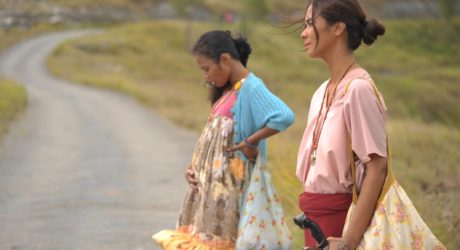
The third feature from acclaimed Indonesian director Mouly Surya, Marlina the Murderer in Four Acts (2017) is a feminist revenge tale for our current moment. The film — which screened in the Directors’ Fortnight at Cannes — is striking not only for its setting on a remote Indonesian island; like all good Westerns, the action runs from start to finish.
cléo had the pleasure of discussing Marlina with Mouly via e-mail over the summer.
In the Western film genre, the protagonist is often marked as such by his superior masculinity. How did this archetype play into your conception of Marlina as a character?
I think because the conception of her character came to me first, I never really tried to fit or unfit her to the archetype of the genre. It works the other way around for me. I used the genre as a flexible tool to tell her story and flip it to fit her and the story. So it is a matter of seeing her as a masculine figure through the lens.
Marlina is a particular character from the start. She doesn’t say much and there is an air of mystery around her. Lots of credit must also be given to how Marsha [Timothy] brings such elegance and stoicism to her character — those kinds of things aren’t really directable, it must come from within. All I did was give her a prop head of her rapist and put her on a horse, and then asked the music to blow some horns.
The Western genre’s archetypes are really that simple, perhaps the most simple, due to its specificity, in my opinion — so simplistic at times that giving layers and subtexts beneath its external form really is as easy as you can imagine, and quite easy for the audience as well. I really had a lot of fun playing with the audience’s expectations in this film.
The women in the film — Marlina, Novi, Yohana, and Topan — show each other a great deal of trust. Can you speak to allyship as a means for survival between the key female characters?
The story that I received from [writer] Garin Nugroho had this in a less specific way. The last act before it was rewritten was a scene of Marlina at a village celebration when all the women stood by her to fight off the bandits wanting the head in her hands. I took that conception and put it in these three new characters (Novi wasn’t completely “new” as in the original story she had a small appearance giving birth with the help of Marlina). Novi is Marlina’s mirror image as a conception. She’s bubbling with happiness, considerably younger, and hasn’t gone through what Marlina has gone through, but she kind of looks up to Marlina. There is some kind of envy at first between them, something I think every woman will understand when one has something that the other doesn’t have.
With Yohana as an older woman, and Topan being younger, I didn’t only want to see these women stand together, I wanted to examine how they represented different generations of women — how Yohana wanted to instill her wisdom and understanding to them, in a comedic way; and how Topan has her big and naive dreams that she as a girl can grow up and become a “man.”
The trust came later for Marlina and Novi (even though their first meeting in the film wasn’t the first time they’d ever met), but it is kind of a given for Yohana and Topan. I thought that was interesting. Petty competitiveness between women is real. I didn’t like it, but it was very real and universal. But how in the end they stood together to survive was a very important message that I wanted to portray.

The women are also very funny. How did you balance humour with the violence depicted in the film?
The funny thing is, [the film] was never meant to be that humorous at all. But people said my films have always been kind of quirky. When we wrote the script, I only chuckled at a couple of lines. But with the extremity of the situation depicted in the film, I guess it works well in the end. It has a lot to do with spontaneity and delivery. We managed to find a great balance in the editing. What Garin Nugroho said was interesting: after several premieres at film festivals — because his original story wasn’t meant to be funny at all — he said it is because the situation in the film is so extreme [that] it becomes an irony. I guess that irony becomes a setup for the audience when they see other scenes that weren’t that funny without that context. So the answer is: good ol’ movie magic.
What has been your experience sharing the film with Indonesian audiences?
Interesting experiences, I’d say. Different than with the international audience, [Indonesian audiences] had more of a context so [their experience of the film] really depends on that context. Due to the popularity of social media in Indonesia, I interacted with lots of them. People who loved the film created a lot of great fanart, on a scale I’d never really encountered for an “arthouse” film here, a label applied to my previous films by the people in the local industry and media. Someone made a poster during the Women’s March of Marlina, and I don’t know whether it is her intellectual property or mine, or both, because she scolded me on Instagram when I reposted her picture for not giving her a proper credit on my post. Aside from criticism that I didn’t use real people from the island instead of professional actors and actresses to play the characters (I am open to criticism but I don’t get why actors aren’t considered real people), I heard that in some commercial theatres the audience gave standing ovations after screenings which was the most touching thing for me.
This text has been edited and condensed for length.
Originally published on July 18, 2018





